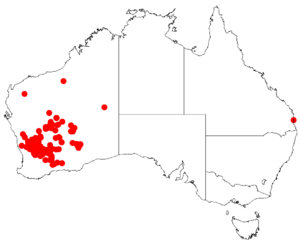Acacia heteroneura facts for kids
Quick facts for kids Acacia heteroneura |
|
|---|---|
| Scientific classification | |
| Genus: |
Acacia
|
| Species: |
heteroneura
|
 |
|
| Occurrence data from AVH | |
Acacia heteroneura is a type of shrub. It belongs to the large Acacia family. This plant is special because it grows only in western Australia. This means it is endemic there.
About the Plant
This shrub usually grows between 0.5 to 3.5 metres (2 to 11 ft) tall. Its branches have fine, silky hairs. They also have sticky, smooth ridges. Like many Acacia plants, it has phyllodes instead of true leaves. Phyllodes are flattened leaf stems that act like leaves.
The phyllodes are long and narrow. They can be flat or sometimes round. These stiff, silvery-green to grey-green phyllodes are 3 to 13 cm (1.2 to 5.1 in) long. They are 0.7 to 3.5 mm (0.028 to 0.138 in) wide. They are either harmless or have a slightly sharp tip.
This plant blooms all year round, from January to December. It produces bright yellow flowers. The flowers grow in simple clusters. These clusters appear alone or in pairs. They grow where the leaf meets the stem, called the axil.
The flower-heads are round or oval-shaped. They are 5 to 9 mm (0.20 to 0.35 in) long and 5 to 8 mm (0.20 to 0.31 in) wide. They are packed with many golden flowers. After the flowers, seed pods form. These pods are usually upright and long. They can be straight or have four sides. The tough, woody pods can be up to 10.5 mm (0.41 in) long. They are 1.5 to 3 mm (0.059 to 0.118 in) wide. Inside, the seeds are arranged lengthwise. The seeds are shiny and mottled. They are narrow and oblong or oval-shaped. They measure 3 to 5.5 mm (0.12 to 0.22 in) long.
How It's Grouped
Acacia heteroneura gives its name to a special group of Acacia plants. This group includes Acacia cylindrica, Acacia desertorum, and Acacia epedunculata. A. desertorum is its closest relative.
There are four different types, or varieties, of Acacia heteroneura:
- Acacia heteroneura var. heteroneura
- Acacia heteroneura var. jutsonii
- Acacia heteroneura var. putila
- Acacia heteroneura var. prolixa
Where It Grows
This plant naturally grows in western Australia. You can find it in the Goldfields, Wheatbelt, and Pilbara regions. It is spread out in different places.
It often grows on sand dunes, flat sandy areas, ridges, and rocky hills made of laterite. It prefers gravelly sandy-loam soils. Most of these plants are found from Wubin in the west. They stretch to Wiluna in the northeast. They also reach Lake King in the southeast. You can also find them as far east as Queen Victoria Spring Nature Reserve. Here, they usually grow as part of open scrubland areas.

